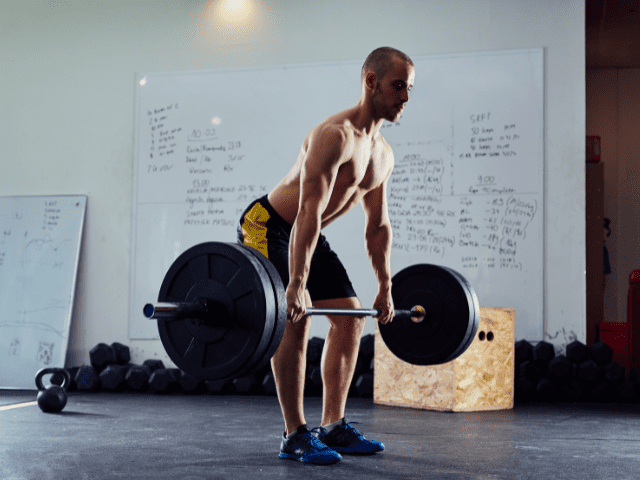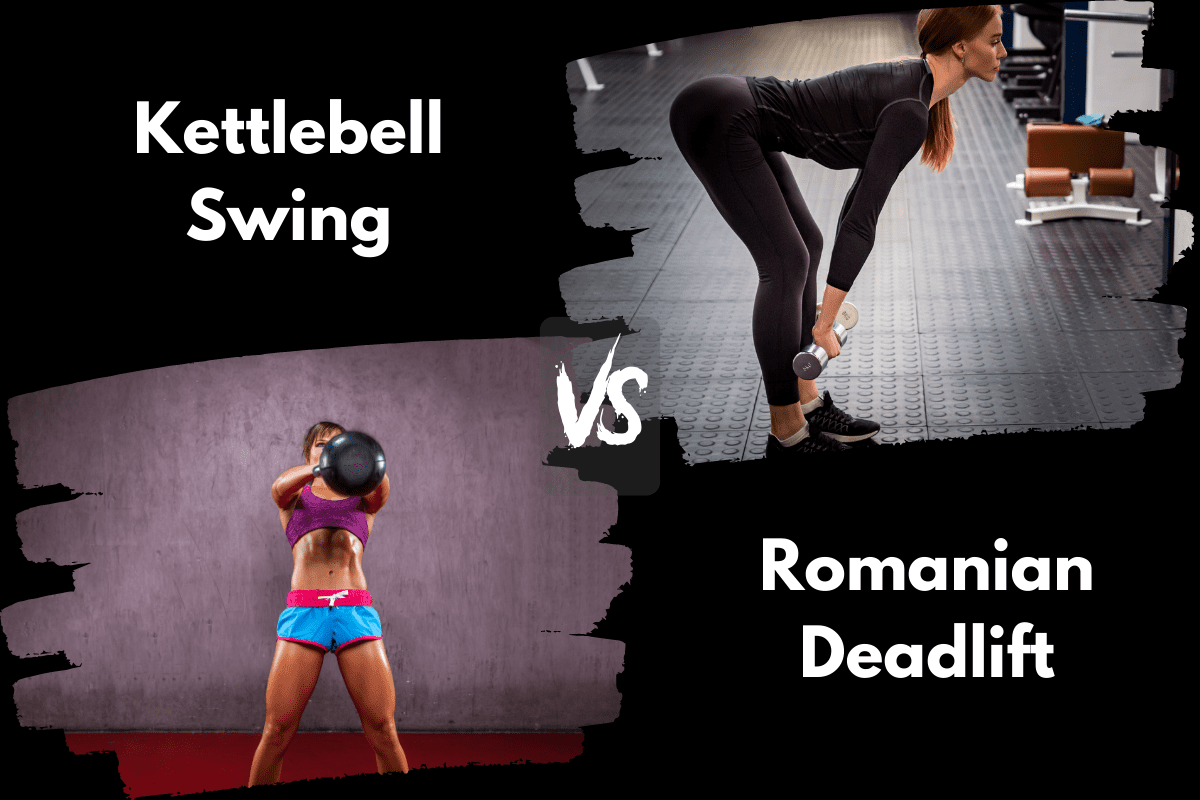Kettlebell Swing vs Romanian Deadlift (Full Comparison)
When it comes to building a strong and functional posterior chain, the Kettlebell Swing and Romanian Deadlift, or RDL, are two popular options. While both exercises target similar muscles, there are some key differences between them that can impact their effectiveness for different training goals.
The Kettlebell Swing is a dynamic movement that involves a powerful hip hinge to generate momentum and swing the kettlebell. It primarily targets the glutes, hamstrings, and lower back, while also providing a cardiovascular challenge if done at higher volumes.
On the other hand, the Romanian Deadlift is a slow and controlled exercise that emphasizes eccentric muscle contractions but also focuses on the hamstrings, glutes, and spinal erectors. It is often used as a strength and hypertrophy exercise, as well as a warm-up movement if done at lighter weights.
In this article, I’ll take a closer look at the differences between Kettlebell Swings and Romanian Deadlifts, and discuss the proper technique and benefits of both exercises.
Kettlebell Swing

Equipment Needed
- Kettlebell (you can also use a dumbbell by grabbing the end of it)
Step-by-Step Instruction
- Approach the kettlebell with a stance slightly wider than shoulder width.
- Take a deep breath, slightly bend the knees, hinge at the waist, and squeeze the kettlebell with both hands.
- Maintain a neutral spine, eyes focused on something just in front of you. (DO NOT CRANE THE NECK).
- Initiate the movement by pulling the dumbbell off the ground and into the “power position”.
- The power position is where the hips are flexed (loaded), knees are slightly bent, and you are now going to drive the kettlebell forward.
- Extend the hips and knees (DO NOT LET GO OF THE KETTLEBELL), driving the kettlebell forward.
- The kettlebell will drift from the hip extension to about shoulder height but should not go any higher.
- Gravity will bring the kettlebell back down.
- Actively “pull” the kettlebell back to the power position. You should never feel loose or out of control as you swing.
- As you pull the kettlebell and prepare for the next rep, remember to keep a tight abdomen and upper back.
- This movement is fast and works on rapid force development via hip and knee extension.
Coaching Points
The Kettlebell Swing is a great movement to train rapid hip extension and flexion. Remember to always keep a neutral spine (DO NOT ROUND YOUR BACK).
Choosing the proper kettlebell weight is important. Heavier is not always better. Because of the rapid nature of the kettlebell swing, the emphasis should be on velocity, speed, and power.
I would recommend starting light and you will be able to increase weight easily as you get more comfortable with the movement.
I highly recommend novice lifters to start with the kettlebell swing before moving to more complicated movements such as cleans or snatches.
RELATED –> 10 Kettlebell Swing alternatives to develop explosive power
Benefits
Some of the potential benefits of this exercise include:
- It can improve overall strength and power. Kettlebell swings require the use of large, explosive movements, which can help to increase strength and power in the upper and lower body.
- It can improve cardiovascular fitness. Because kettlebell swings are a high-intensity exercise, they can raise the heart rate and improve cardiovascular endurance.
- Kettlebell swings require the engagement of the core muscles to maintain proper form, which can help to improve posture and core stability.
- It can be a fun and engaging workout. Kettlebell swings are a versatile exercise that can be easily adapted to fit a variety of fitness levels and goals, making them an enjoyable and effective workout option.
Romanian Deadlift

Equipment Needed
- Barbell
- Weight Plates (Bumper or Iron)
How To
- Address the bar with feet shoulder-width apart, and toes straight ahead.
- Use a pronated grip about a thumb length from the start of the knurling.
- Now, with a good flat back, pick the bar up to a standing position.
- From here, put a slight bend in the knees and ‘set the back’ by squeezing the shoulder blades and engaging the lats.
- Brace the core and hinge forward by pushing the hips back.
- The bar should almost drag right down the legs, across the knees and straight down the shins. The whole foot should stay flat on the ground, but the weight should be on the mid-foot to heel.
- Maintain the neutral spine position throughout the descent and once you feel a good stretch in the hamstrings, drive the hips forward (hip extension) and return to the starting position.
Coaching Points
The ‘depth’ that each person gets doing Romanian Deadlifts will be different and absolutely solely dependent upon hamstring flexibility.
Do NOT try to ‘reach’ the barbell toward the ground because you believe the plates should touch the floor. If you have tight hamstrings you may be doing well to get the bar to mid-shin. Trying to reach the bar to the floor will result in the lifter losing their neutral spine and rounding their back… which leads me right into common RDL mistakes.
Easily the most common mistake (and easily identifiable) that I see with athletes for a Romanian deadlift is rounding the back. This is usually due to either poor technique or simply using too much weight. Use less weight if necessary and work on being able to keep the back engaged and the spine in a neutral position throughout the entire exercise.
Rounding the back puts a lot of stress on the spine and can be very dangerous if not corrected. This absolutely has to be a main point of emphasis.
Another common RDL mistake is excessive bending of the knee. Try to maintain a slight knee bend with all of the movement coming from the hip hinge. More bend in the knees basically turns the movement more into a conventional deadlift rather than an RDL.
RELATED –> 11 RDL alternatives that will develop your posterior chain
Benefits of the RDL
The RDL, also referred to as a stiff leg deadlift, is a great exercise to work the posterior chain muscles, specifically the hamstrings, glutes and erector spinae of the low back.
Many of the movements that I utilize with athletes demand a very strong posterior chain (as does many sports movements as well). Olympic lifts, Back Squat and Front Squats are all great exercises for building strong, explosive athletes and all three demand a strong posterior chain.
Romanian deadlifts work as a terrific accessory lift to aid in the development of those bigger compound lifts.
Finally, the Romanian deadlift, as part of a holistic approach to strengthening the hamstrings and exposing the hamstrings to high-speed running can lower the risk of hamstring injuries.
Kettlebell Swing vs RDL: Which is Better?
Now, let’s take a side-by-side look at both exercises and discuss if one is better than the other for some common lifting goals.
Better For Developing Strength and Size: RDL
First and foremost, both exercises can do a good job of improving both strength and muscle mass. One could make the argument that Kettlebell Swings are even better for power development because the it’s a more explosive movement.
For strength though, I give Romanian Deadlifts the edge. And, to be honest, it’s almost more of a logistical reason than it is a technical one. Let me explain.
As you continue to get stronger, you can easily continue adding plates to the bar for RDLs. On football teams I’ve worked with, it’s pretty common to see guys using anywhere from 185 pounds to 315 pounds for sets of Romanian Deadlifts.
The odds that you have access to a kettlebell even remotely that big are slim to none. So, there will be a point in time when a kettlebell is just not going to be able to provide you with enough resistance to continue developing strength and size the way RDLs will.
Better For Beginners: Kettlebell Swings
Both exercises have a decent amount of technique involved that needs to be done correctly to ensure the lift is safe. However, I give the nod to Kettlebell Swings as being better for beginners for two reasons.
First, assuming you have access to a good selection of kettlebells, you should be able to start with a really light kettlebell if need be. This makes the Kettlebell Swing relatively safe as you learn proper technique. Then, you can slowly progress up in weight as you become proficient in the movement and stronger.
Second, for most beginners, working with a kettlebell rather than a barbell can be less intimidating. To be honest, I’m not 100% sure why that is, but in my experience that tends to be the case.
Whatever exercise you choose as a beginner, always remember to start light, learn proper technique first and then (and only then) start to progress up to heavier weight.
Final Thoughts
I just spent the back half of this article comparing if Kettlebell Swings or Romanian Deadlifts are better than the other. The truth is, assuming you have the proper equipment, there is no reason you can’t have both exercises in your strength training program.
Both exercises are effective and actually can complement each other well. Plus, by utilizing both exercises you can add variety to your workouts and keep them from getting stale.
So, my final suggestion is to figure out how you can incorporate both Kettlebell Swings and Romanian Deadlifts into your training.

